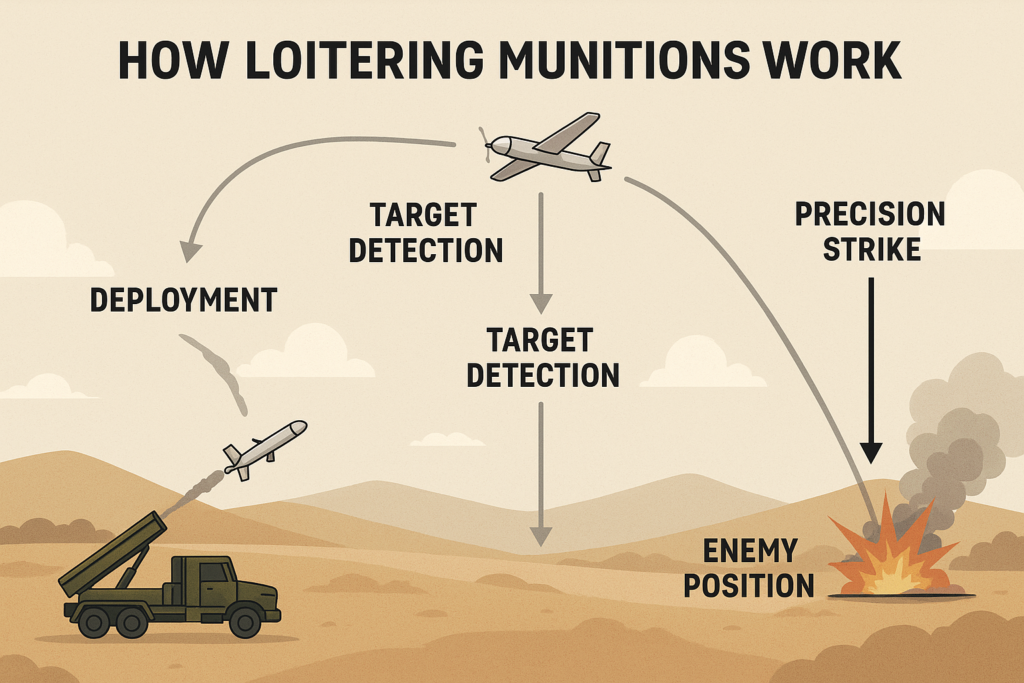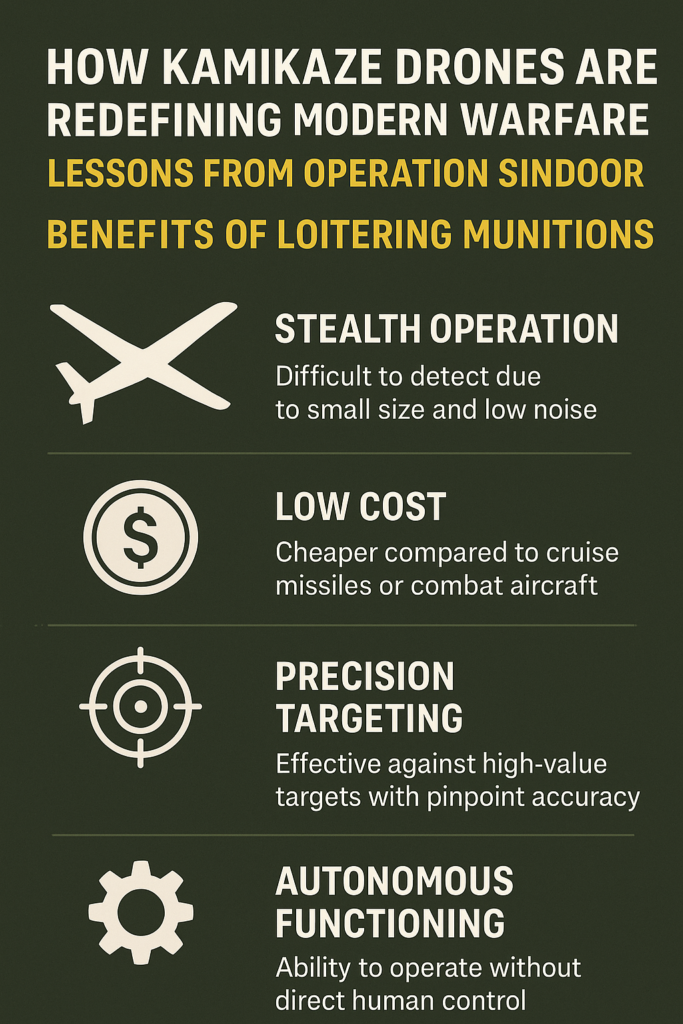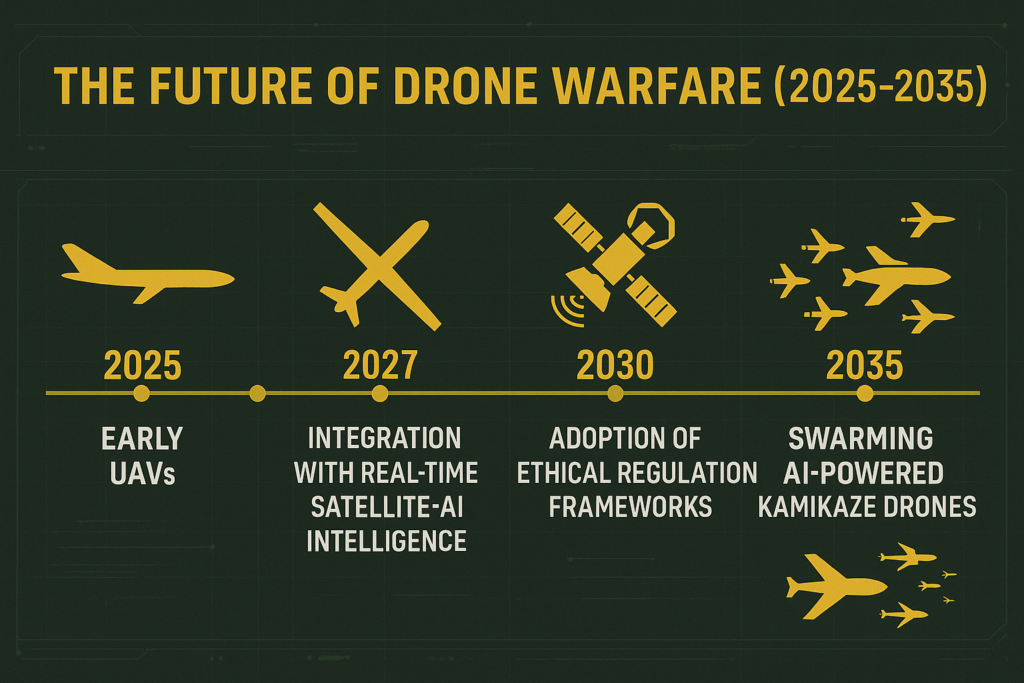Imagine a soldier sitting miles away from the battlefield, launching a drone that loiters in the sky, silently identifying targets and striking with pinpoint accuracy. This is not science fiction—it’s the new face of combat. In recent military operations like Operation Sindoor, kamikaze drones, also known as loitering munitions, have transformed the landscape of warfare, ushering in a new era of autonomous precision.
In this post, we’ll explore how loitering munitions are changing military strategies globally, the technical workings behind these drones, ethical implications, and lessons from real-world operations that offer a glimpse into the future of warfare.
What Are Loitering Munitions?
Loitering munitions are a hybrid between a drone and a guided missile. Unlike traditional missiles that strike predetermined targets, loitering munitions hover or “loiter” in a designated area, identify enemy assets in real-time, and strike with lethal precision.
Key Characteristics:
- Autonomous or semi-autonomous targeting
- Lightweight and portable
- Real-time surveillance and strike capabilities
- Low cost compared to traditional munitions
These systems are often man-portable, launched from vehicles or hand-held platforms, making them highly versatile in asymmetric warfare.

Operation Sindoor: A Tactical Case Study
Operation Sindoor was a covert mission that employed a combination of intelligence, surveillance, and loitering munitions to neutralize high-value insurgent targets in a rugged border terrain. Kamikaze drones played a pivotal role by:
- Loitering over hostile zones undetected for hours
- Identifying thermal signatures and movement using AI-powered imaging systems
- Delivering precision strikes with minimal collateral damage
The operation demonstrated the tactical advantages of loitering munitions in environments where traditional airstrikes or infantry incursions were too risky.
Key Takeaways:
- Reduced need for manned operations
- Enhanced mission flexibility and reaction time
- Minimal risk of friendly fire or civilian casualties
How Loitering Munitions Work
1. Deployment
Launched from a catapult, canister, or mobile platform.
2. Loiter Phase
The drone enters a flight pattern over a target area, scanning using optical, infrared, and radar sensors.
3. Target Acquisition
AI-driven algorithms analyze sensor data to identify threats. Human-in-the-loop systems can intervene for manual confirmation.
4. Strike
Once a target is confirmed, the drone dives and detonates on impact.
Technical Components:
- AI/ML-powered target recognition
- GPS and inertial navigation systems
- Data links for real-time communication
- Explosive payload with directional accuracy

Strategic Benefits of Kamikaze Drones
1. Precision & Minimal Collateral Damage
Smart targeting ensures only intended targets are struck.
2. Operational Flexibility
Ideal for dynamic conflict zones, urban warfare, and inaccessible terrains.
3. Cost-Effective Warfare
Loitering munitions are significantly cheaper than deploying fighter jets or missiles.
4. Reduced Soldier Risk
Remote operation from secure locations minimizes troop exposure.
5. Surprise and Stealth
Small size and low radar signature make them hard to detect.
Ethical Risks and Challenges
Despite their tactical advantages, loitering munitions raise serious ethical and legal questions:
1. Autonomy and Accountability
Who is responsible if an autonomous drone makes a wrong kill decision?
2. Civilian Impact
Misidentification or system errors can lead to unintended casualties.
3. Lack of International Regulation
Current laws lag behind the pace of autonomous weapon deployment.
4. Dual-Use Technology
Civilian tech (e.g., AI image recognition) can be repurposed for lethal outcomes.
Example: In a 2020 skirmish, a loitering munition reportedly misfired due to GPS spoofing, targeting a humanitarian convoy.
Future of Loitering Munitions
🌎 Swarm Technology
Drones operating in coordinated swarms to overwhelm enemy defenses.
🌎 Integration with Satellite AI
Real-time space-based intelligence feeding into drone decision-making.
🌎 Urban Warfare Dominance
Smaller, quieter munitions suited for dense urban environments.
🌎 Defense as a Service
Private contractors offering drone strike capabilities on-demand.
Market Insight: According to Market Research Future, the loitering munitions market is expected to grow at a CAGR of 10.8% between 2024 and 2030.

Global Regulations and Balancing Innovation
International Norms
- Geneva Conventions: Still ambiguous on autonomous systems
- UN CCW Meetings: Ongoing discussions on lethal autonomous weapons
National Policies
- DPDP Act & GDPR: May indirectly regulate data handling in AI-powered drones
- Defense Procurement Guidelines: Encourage ethical sourcing and R&D transparency
Solutions:
- Enforce “human-in-the-loop” decision-making
- Mandate fail-safe overrides in autonomous drones
- Build international drone accountability frameworks
FAQs
1. What makes loitering munitions different from regular drones?
They combine surveillance and attack capabilities, unlike surveillance-only or strike-only drones.
2. Are loitering munitions legal under international law?
Currently, there’s no comprehensive ban, but debates continue on autonomous weapon ethics.
3. Can kamikaze drones be jammed or hacked?
Yes, they are vulnerable to cyberattacks and electronic warfare if not secured properly.
4. Which countries are leading in loitering munitions technology?
The U.S., Israel, China, and Turkey are at the forefront of development and deployment.
5. What role do AI and ML play in these drones?
AI enables real-time object recognition, navigation, and even decision-making in some advanced systems.
Conclusion
Kamikaze drones are not just a tactical upgrade; they’re a strategic game-changer. From reducing troop risk to redefining precision warfare, their impact is already reshaping battle doctrines worldwide. Yet, with great power comes great responsibility. As we stand on the brink of a drone-dominated future, global cooperation, ethical frameworks, and technological safeguards are essential.
What are your thoughts on the rise of loitering munitions? Share in the comments below!
Reference: UN Report on Lethal Autonomous Weapons
Ready to Stay Ahead? Bookmark our guide Technology and AI for updates!

